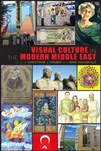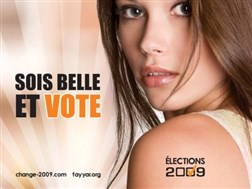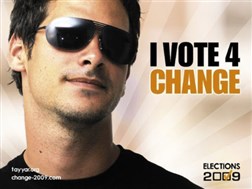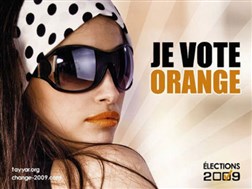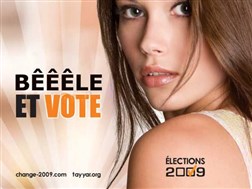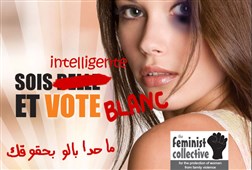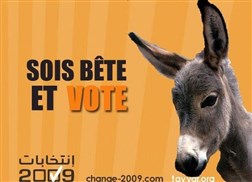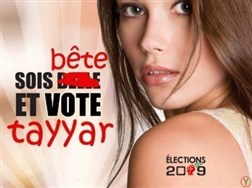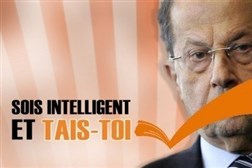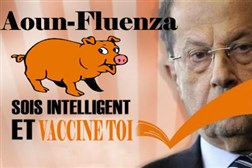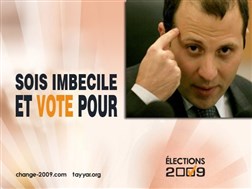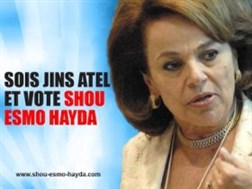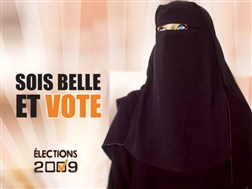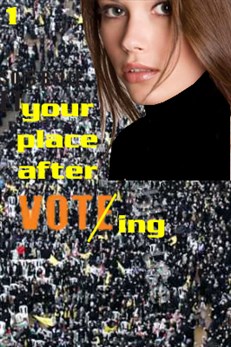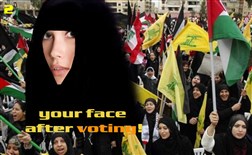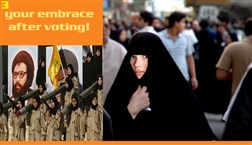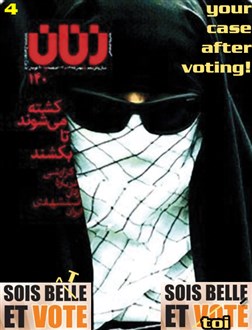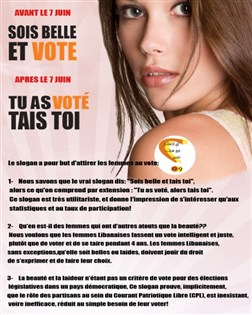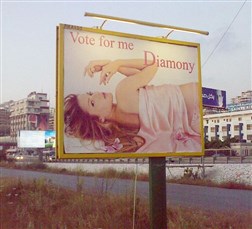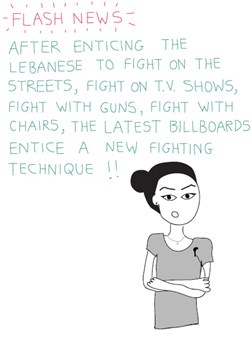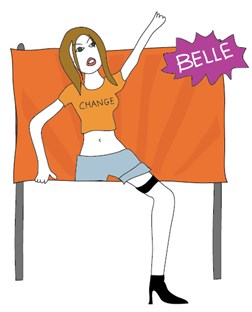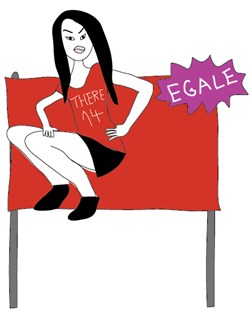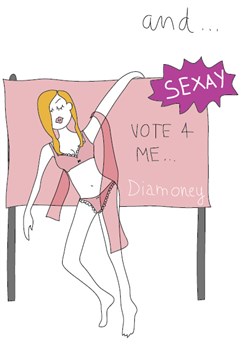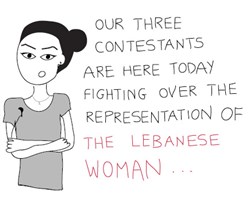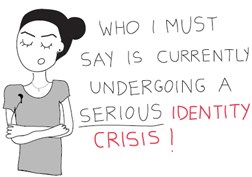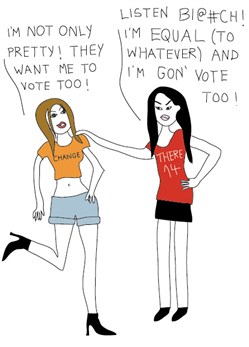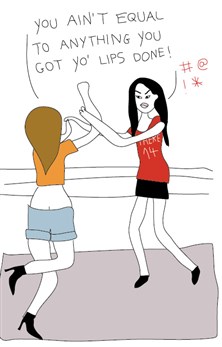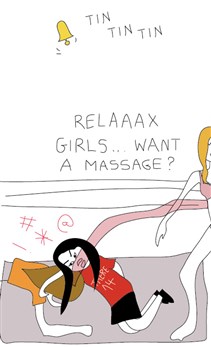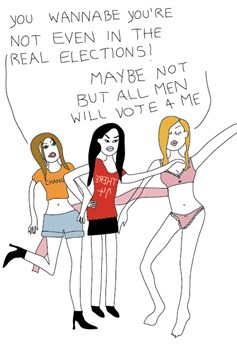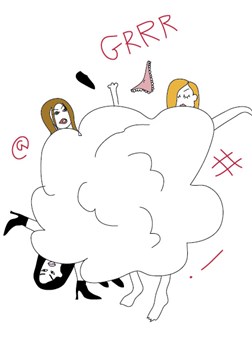In April 2009, the Free Patriotic Movement[1] issued the campaign "Sois Belle et Vote", as part of its broader electoral campaign under the title of "Change and Reform". The campaign consisted of a poster, distributed across the billboards and unipoles throughout Beirut and its suburbs, as well as the Christian areas of the North (fig. 1), and a video, broadcasted simultaneously with the appearance of the posters on the streets. The campaign was designed by Lebanese designer Sami Saab, who studied advertising at ALBA (Academie Libanaise des Beaux Arts), and has been creating campaigns for the 8th of March coalition since 2005. Soon after the release of the campaign, a frenzy of unofficial retorts and anti-campaigns spread out through the Internet. These were created mainly by supporters of the 14th of March coalition, particularly the Lebanese Forces, who represent the main Christian opponent to the Free Patriotic Movemement (FPM), as well as the newly established, Beirut-based Feminist Collective (FC). At the end of May 2009, the 14th of March coalition replied officially to the FPM campaign, with the anti-campaign "Sois Egale et Vote".
In this paper, I will attempt to present and analyze "Sois belle et vote", within the framework of media cultural studies to reach an understanding of how the campaign fails to communicate the intended message, and how this "systematically distorted communication"[2] manifested itself in the official and unofficial anti-campaigns launched in the aftermath of "Sois belle et vote".
Sois Belle et Vote: Poster/tv commercial
The poster (fig. 2) is composed of 3 main elements: a background visual, the main visual, and the accompanying text. The background visual is a gradient from white to orange, of stripes emanating from one source whose virtual location is at the bottom of the poster; this abstract image is representative of the sun and its rays, as it appears at dawn, and the symbolic significance of this representation is informed by the main promise of FPM's political platform: Change and Reform. The main visual is a photographic image of a young brunette, whose stance is not unlike that of "The Girl with the Pearl Earring" in Jan Vermeer's painting (fig. 3). Her torso is directed away from the viewer, but her face is turned towards us. With parted luscious lips, an inviting nonchalant gaze, wispy untamed hair, and a bare, tanned, round shoulder, the total overview constitutes an image of a beautiful young lady, who takes care of her outer appearance. The third element of the poster is the text, in uppercase, bold condensed sans serif typeface: Sois belle et vote. "Sois belle" is typeset in a smaller size than "et vote", creating a stress on the latter, rather than the former.[3] Moreover, all the words are black, spare for "Vote", which is in orange, the official color adopted by the FPM. This distinction with color is an alternative means of saying: vote for orange, meaning - vote for FPM. The poster also includes the words ÉLECTIONS 2009, placed on the young woman's shoulder, to appear as if tattooed. The zeroes in "2009" look like checkboxes, and the second zero is occupied by an orange checkmark. This is reference to FPM's original campaign of "Correct/Wrong" (fig. 4), whereby orange checkmarks are placed next to the word "correct"[4] to imply that the correct choice in the 2009 parliamentary elections is voting for FPM.[5]
The text "Sois belle et vote" is in French, and is a subversion of the original, well-known phrase "Sois belle et tais-toi", which translates roughly into "look pretty and shut up". The original phrase refers to the notion of women as being merely an object of beauty that do not possess any significant opinion worth voicing. The closest idiom in English is "women should be seen, never heard".[6]
The poster's target audience is composed of young Lebanese women who are image-conscious and not politically involved. The choice of image is based on the premise that a young Lebanese woman would relate to and identify with it, which would create a positive association with the slogan. The encoded message - you can be beautiful and vote -attempts to reconcile the concept of beauty with the act of political participation. The image itself, however, operates within the visual language of the world of fashion advertising. Coupled with the usage of a phrase whose historical origin is loaded with connotations of sexism and oppression, it inevitably leads to misunderstanding. Such distorted communication arises at the connotative level of decoding, when the audience fails to operate within the dominant codes of reading.
Moreover, it is important to note that the usage of French in the campaign's message directly limits the scope of the intended audience to just the French-speaking community. With the inherent linguistic differences between any two languages, the meaning of the phrase "Sois belle et vote" is partially lost when an attempt is made to give the non-French-speaking audience an accurate translation. Most of the translations given include an imperative statement: "Be beautiful and vote", "Stay beautiful and vote", "Look pretty and vote". However, the original French phrase is not a command, but rather a comment on the state of beauty, or being beautiful. The differences in decoding the message and the faithfulness of the translation from French to English also affect the reading of the campaign and create two diverse understandings: the former is a declarative statement, the latter a command.
The designer of the campaign, Sami Saab, explained that the audience for this campaign was image-conscious women whom are usually not politically involved, or are forced to vote for a particular party due to familial or marital pressure. "The campaign does pertain directly to the French-speaking community, but the fame of the subverted phrase "Sois belle et tais-toi" did not restrict the non-French-speaking community from understanding the meaning of the campaign either", voiced Saab.[7] "It's a shout-out to all Lebanese women: where are you? Beauty is not enough", Saab explained to Agence France Presse.[8] Saab contradicted himself in a different interview, where he said, "the Lebanese woman is the representation of beauty, and seeks beauty in everything that she does. My aim is to convince her to continue being beautiful, in political participation as well".[9] Saab also claimed to have transformed the sexist attitude inherent in the original phrase "sois belle et tais-toi" into a mobilizing, positive stance towards the Lebanese woman, while encouraging her to actively participate in the elections.
Unofficial public view
Soon after the release of the campaign, the Internet forums started filling up with comments from people of different age groups, sexes, and political affiliations. I will hereafter attempt to summarize the views that were expressed in some of the Internet locations I researched.[10]
One of the comments received emphasized that the campaign was "capitalizing on the image of the glamorous, beautiful, mindless Lebanese woman".[11] This accusation has its ground in the fact that the original phrase "Sois belle et tais-toi" consists of two parts: the first stressing on the concept of the "beautiful" woman (sois belle), and the second commanding the woman to shut up (et tais-toi), because she does not have an opinion worth of voicing, thus assuming that the woman is unintelligent. In subverting the phrase, Saab only changed the second part, maintaining the stress on the concept of "beauty". And although in the poster, Saab created an emphasis on the "et vote" part, by giving it a larger text size, the overall slogan does not make any reference towards what its creators believe of a woman's intelligence. Thus, the slogan does not resolve the problem that women have with the original French saying; the sexist assumption that a woman's worth lies solely in her beauty . In this case, the decoding of the slogan did not correspond with its encoding, because the original message did not include any direct refutation of the claim "women are unintelligent".
Another comment, posted on bloggingbeirut.com,[12] asked "why don't they put a half naked man with great abs and muscles ... Why is it always women?" Aware that the target audience of the Lebanese youth involves men as much as it does women, the FPM released a follow-up campaign, consisting of two posters (figs. 5 and 6). The first shows a young metrosexual male in trendy sunglasses, smiling attractively at the viewer with his head shot back in a relaxed pose. The image is accompanied by the text "I Vote 4 Change" written in the same manner as "Sois belle et vote", with "change" highlighted in orange this time. Exchanging the word "for" by the number "4" is another technique to appeal to the Lebanese youth, as it suggests that the party knows its audience well, and is tech-savvy (knowledge of internet and mobile language). The second poster is dominated by an image of a girl, wearing a fashionable headband and trendy sunglasses. The accompanying text: "Je Vote Orange" emphasizes the word "Orange", this time through the use of orange font, and is complimented by the color of the lipstick that the girl is wearing. Both posters have the same background visual and the same elements as the original campaign. This follow up campaign was instrumental in denouncing any claims that FPM is only using the image of a woman to promote its ideology.
Lebanese journalist Katia (not her real name) created an anti-campaign (fig. 7) in which she intervened upon the words "sois belle", so that the phrase reads "Bêêêle et vote". Katia said that the modification of the original slogan was an expression of a personal, not political commentary. "My slogan clarifies the ad's underlying misogyny, and warns women, if there are any, who may identify themselves with this stereotype, to realize they're being considered as no better than cattle", adds Katia.[13] This comment is highly relevant to the previous analysis of the slogan's failure to directly reject the claim "women are unintelligent".
Another comment maintained, "Ugly Lebanese women have something to say as well".[14] As mentioned earlier, the slogan was sending a twofold message, leaving much to the "subjective capacity"[15] of the interpretation of the audience. The unsuccessful marriage of the concept of beauty to the political mobilization of women opened a wide door for the audience to select which concept FPM was attempting to push forward more. The comment of the female mentioned above shows clearly that her understanding of the slogan was reserved merely for its first part.
Along similar lines, another blogger expressed her outrage at the campaign for saying that women who will not vote for FPM are ugly. This comment is grounded in the fact that in attempting to attract female voters with the compliment "beautiful", the campaign is unintentionally saying that those women who will not vote for "change"/ "orange" - thus FPM-- are "not beautiful".
Feminist Collective Replies
The Beirut-based Feminist Collective denounced the campaign as being "sexist" and "directly offensive" to women.[16] FC created a twelve-point platform to argue their position, as well as an anti-campaign (fig. 8).[17] FC argued that the release of a campaign that targets women and attempts to give them importance, right before the election period, only shows that the real agenda behind the campaign is to collect voters. The Collective also argues that changing "shut up" to "vote" does not do the slogan justice, a point I have highlighted earlier. The Collective also voiced protest to the campaign's usage of the general concept of beauty to appeal to women, because it has no relevance to the democratic process of electing a parliament, and is inadvertently implying that women are "too stupid to engage in real-life politics". Another point argued in the platform proposed that what FPM is really saying is: "Hey, men! Look at us! We have hot women! Vote for us!" This argument is based on the previously mentioned notion of the main image of the campaign using the language of fashion advertising, and thereby falling under the tactic of "sex sells". The campaign, therefore, seems to appeal to men rather than women, which is why the decoding of the embedded message is obstructed. The usage of this particular style of photographic depiction of young females creates in the viewer a direct association with the naturalized image of the female appearing excessively in product advertisement, for which the tactics are to attract men through primitive instinctual drives.
Several more points were pushed forward by FC, mostly falling under the main argument that to attract women voters, FPM should have at least the promise of catering to their needs, and giving them adequate representation in the parliament. FPM, in fact, included only one female candidate in its candidacy lists (Gilberte Maurice Zouein), but did not include women's rights as a priority within the nineteen-point platform that it issued. The Collective suggested that instead of using great sums of money to create a campaign that pretends it knows women, FPM should invest that money into issues that Lebanese women truly care about, like protection from family violence, sexual harassment, and women's rights to nationality, among other equally important topics.
The FC also touched upon the heated issue of women's self-image, saying that inappropriately anchoring the campaign with an image of a slim, good-looking model, and attempting to construct the image of the "Lebanese woman", contributes to further putting pressure on Lebanese females to conform to that image, which does not represent reality and is not a standard that should be advertised in the first place. In her book, "The Beauty Myth", Naomi Wolf argues that men use "images of female beauty as a political weapon against women's advancement".[18] Wolf correlates women's breaching of the power structure during the last decade with the exponential rise of eating disorders and cosmetic surgery. Taking this argument into consideration, it seems contradictory that FPM would attempt to appeal to Lebanese women with an image of a beautiful female, meanwhile mobilizing them to vote; for according to Wolf, the very usage of images of a female whose appearance is hard to measure up to is a means of political deterrence.[19]
The anti-campaign that the Feminist Collective created (fig. 8) shows the same young female with a black eye, referring to the reality of domestic abuse and violence against Lebanese women. The text has been intervened upon through the crossing out of the word "Belle", writing "intelligente" instead, and adding "Blanc" after "Vote", so that the slogan reads "Sois intelligente et vote blanc" ("Be intelligent and insert a blank vote"). Underneath the original slogan, the phrase "Nobody cares about your rights" is written in Arabic, and the logo of the Feminist Collective replaces the logo of "Élections 2009" on the girl's shoulder. The overall message of the new poster urges women to be smart and not vote for any party until they exhibit genuine concern for women's rights. The arguments that the Feminist Collective pushed forward against the message that they decoded from the original campaign are manifested in the crossing out of the word "belle" (concern over the usage of the concept of beauty), its replacement with the word "intelligente" (reaction to the failure of the campaign to bring up the intelligence of a woman), and the addition of the black eye and the phrase "No one cares about your rights" (failure of the FPM platform to include women's rights or the issue of domestic violence).
14th of March Unofficial Replies
More anti-campaigns cropped up on blogs, mostly created by supporters of the 14th of March coalition, and I will attempt to classify them according to the arguments that they were proposing, from the most basic to the most complex.
Subverting Towards the Complete Opposite
Those who decoded the message of the campaign as saying, "women who vote for FPM are beautiful", came up with variations to the slogan "Sois Bête et Vote" ("Be Stupid and Vote") (figs. 9 and 10). The first replaces the image of the young female with an image of a donkey, while the second retains the image of the girl, but intervenes on the slogan, by crossing out "Belle", replacing it with "Bête", and writing "Tayyar" after "Vote". The latter also intervenes on the colors and the "ÉLECTIONS 2009" logo on the girl's shoulder; the slogan is written in black, the intervention is placed in red, and the second checkbox/zero is now replaced with the 14th of March coalition logo (the red fist holding a green branch), instead of the previous orange checkmark.
The above anti-campaigns seem primitive in that they do not give much thought to the message that the original campaign was attempting to send, and did not benefit from the gaps in its decoding as much as those whose anti-campaigns I will exhibit shortly.
Mocking the Leader of the Movement
More of a gesture of derision than a thought-out anti-campaign, the next three figures (figs. 11, 12, and 13) are meant to ridicule General Michel Aoun and one of his candidates (as well as his son in law) Gibran Bassil. In the first figure (fig. 11), Aoun's photograph replaces that of the girl's, with an orange checkmark covering his mouth. The slogan now reads: "Sois Intelligent et Tais-Toi" ("Be Intelligent and Shut Up"). This reaction is possibly a commentary (fueled by personal views) on the miscommunication that the original campaign faced. This reaction may be saying: Do not meddle in things you do not understand, like attracting female voters; be intelligent and shut up. Then again, this subversion may be a mere subjective attempt at ridiculing the leader of the party. The next figure (fig. 12) capitalizes on the epidemic of animal-borne diseases, and fuses the electoral campaign with a current issue (the swine flu), by adding the caption "Aoun-Fluenza" along with a comic illustration of a pig, and changing "Vote" to "Vaccine Toi" ("Vaccinate yourself"). The last figure (fig. 13) shows a photo of Gibran Bassil with his finger pointed towards his head. The caption is a play on rhyming words, saying: "Sois imbecile et vote pour [Gibran Bassil]" ("Be an Imbecile and Vote for [Gibran Bassil]"). The creator of this poster did not include the name of the Minister, but rather substituted it with a photo; thus basing the approach on the premise that the viewer should be able to recognize the politician from his photo alone. It is essential to note here that, so far, the anti-campaigns rely heavily on their message to be decoded within the dominant codes, which include the recognition of the subjects of derision and being up-to-date with current global issues.
Mocking the Opposing Leaders: Reaction of the FPM
Figure 14 represents the reaction of the FPM supporters to the acerbic commentary of 14th of March supporters. Posted soon after the Michel Aoun and Gibran Bassil 'spoof' campaigns, FPM supporters benefitted from the recent footage of Walid Joumblat (leader of the Progressive Socialist Party, part of the 14th of March coalition) caught ridiculing his Christian allies, and calling them a "dysfunctional breed", as well as forgetting the name of his Lebanese Forces' ally Samir Geagea, and referring to him as "what's his name".[20] The poster uses a blue background (the official color of Future Movement; part of the 14th of March coalition), the image of Nayla Mouawwad (part of the 14th of March coalition), and the slogan: "Sois Jins Atel et Vote Shou Esmo Hayda" ("Become Dysfunctional Breed and Vote What's His Name"). The poster is successfully able to poke fun at four of the 14th of March coalition leaders and, similar to the cases before, requires the viewer's erudition and recognition of the dominant codes, such as the significance of the color blue, the phrases "Jins Atel" and "Shou Esmo Haida", as well as the photograph of Nayla Mouawwad.
Capitalizing on a Common Threat
The next set of anti-campaigns (fig. 15 and figs. 16 - 20) takes up the issue of FPM's alliance with Hizbullah, an Islamist, predominantly Shiite party, and comments on the Lebanese Forces' voiced concern about whether the campaign "Sois Belle et Vote" was actually approved by FPM's ally, or even distributed in the areas of Hizbullah's presence. The girl in the first figure (15) was replaced by a completely veiled woman, while retaining the adjacent slogan, "Sois belle et vote". The message this poster sends out is: if you vote for FPM, and FPM wins the elections, this is what you will look like. The assumption that being veiled is threatening can only be understood within the Christian mindset. Alan Gowans comments on the issue of irrational association as being the preceding step for psychological hard-sell advertising, along with compulsive symbols, illustration, and scientific calculation.[21] I am concerned in this case with irrational association in particular, seeing as veiling is a decision that only Muslim women take, and it in no way represents a threat to the Christian community. Nevertheless, manipulating the sensitivities of Christian women by presenting the image of a veiled woman relies heavily on the audience to make an irrational association, and decode the image of the veiled woman as being a threat. Figures 16-19 present a sequence in which only the image of the young woman from the original campaign is retained, while being progressively covered in black. Fig. 16 adds a bold yellow "and????" to the original poster, raising the question of what will follow if one votes for FPM. Fig. 17 reads "your place after voting", with the same girl covered up to her neck in black, and with a background photograph taken from one of the March 8th rallies. Fig. 18 reads "your face after voting", depicting the girl veiled in black with only her face uncovered, against a background photo of veiled women in another March 8th rally. Fig. 19 reads "your embrace after voting", with the girl veiled in black and wearing a black abaya, against a background photograph of female Hizbullah supporters in a symbolic display of resistance, holding rockets on their shoulders. The final image in the series (fig. 20) reads "your case after voting", with an unrecognizable, veiled woman whose face is completely covered by a Palestinain kuffiya. Only the sunglasses that the girl was wearing in the original TV ad and the follow-up poster (fig. 6) are added, to suggest that it is the same girl. The image is presented in a way that suggests the girl is on the cover of an Iranian magazine. The entire sequence touches upon issues that the Lebanese Forces consider threats: the veiling of women, Hizbullah's armed resistance, Hizbullah's connections with Iran, and involvement with the Palestinian cause. Yet again, the creators of the sequence rely heavily on irrational association of these issues to be a threat to the Christian community.
Revealing a Hidden Agenda
Another poster (fig. 21) was created before the official reply of the Feminist Collective, voicing similar concerns about the relevance of beauty to the democratic process of electing a parliament. The poster extends the original layout of the campaign, and alters the slogan to read: "Avant le 7 juin Sois belle et vote" then "Apres le 7 juin Tu as voté, tais toi" ("Before the 7th of June, Be Beautiful and Vote" "After the 7th of June, now that you have voted, shut up"). The creators of this campaign decoded the original slogan to be the first part of a discontinued sentence. This voices the creators' concern over FPM's "pretense" of wanting to change the situation of the Lebanese woman, while their true agenda is that of merely collecting votes. The accompanying text[22] (written in French) explains the concerns of the poster's creators, and a big orange and yellow question mark is placed on the girl's shoulder with Arabic text stating: What reform with such a change? (referring to FPM's platform of "change").[23]
14th of March Official Reply
The official reply of the 14th of March coalition (fig. 22) came at the end of May 2009 and was distributed throughout the same areas as the FPM campaign. However, it did not gain as much fame and recognition as the former. The poster's main image, set against a flat red background, is that of a good-looking girl (some voiced the opinion that she looks prettier than the girl used for the FPM campaign), facing the viewer, bearing all the signs of being equally involved with her looks, but with a determined expression on her face. The slogan reads: "Sois egale et vote" ("Be equal and vote"). The only other element in the poster is the 14th of March logo (the fist bearing the green branch). In comparison to with the FPM poster, it seems the 14th of March were commenting on the FPM campaign's failed usage of the concept of beauty to appeal to women, while trying to empower them and mobilize them to vote. Their slogan, instead, proposes that women should be equal and vote. The setbacks of this proposition however, are that their usage of the term "equal" is vague, as it is indiscernible what they are proposing a woman should be "equal" to. Are they saying that a woman should be equal to men, or equal to the women who support FPM? Another problem with this reply is that the main image still belongs to the realm of advertising products for men, while the slogan is telling women to be "equal". The creators of this anti-campaign did not get to the bottom of the issues that the FPM campaign suffered from, and thus failed to communicate the "corrected" version as well.
Advertising benefits from "Vote for (insert text here)" frenzy
Around the time of the release of the 14th of March anti-campaign, the fashion lingerie company Diamony launched a campaign (fig. 23) parodying both the FPM and 14th of March "Sois Belle/Egale et Vote" posters. Set against a dreamy pink background, a young female appears to be naked underneath a pink silk blanket, suggestively posing while lying on the ground. The slogan reads: "Vote for me Diamony". The poster uses the same simple elements of the campaigns it parodies: the image of a girl and a bold slogan. However, the image of the girl this time does not seem out of place, as it lives within the frame of a fashion advertising and appears to be completely natural for its surroundings. The advertisement would not have looked out of place had it been taken outside of the context of elections, and the message would still be effective even if it had not been referencing the campaigns created by FPM and the 14th of March.[24]
Conclusion
Sami Saab, the designer of the FPM campaign, mentioned in one of his interviews that the more fame generated by a campaign, the better.[25] "This means that the campaign becomes on everyone's tongues, and gains wide exposure; when this happens, I consider my job done". The aim of electoral campaigns has shifted from persuading potential supporters to vote, to gaining attention and exposure and being memorable. Saab stated as well that he was not put off by the anti-campaigns and parodies that were created against "Sois Belle et Vote", because he considered that "this is a healthy situation of a democratic country, where everyone has a right to express their opinion". What helped the "Sois Belle et Vote" campaign in that respect is the malleable form of the slogan, the catchiness of the phrase, and the gaps that the analysis of the campaign had revealed. The discussion generated across billboards, newspapers, and Internet blogs proves that the campaign is the first in the history of Lebanese electoral campaigns to have gained such significant attention. Comments went as far as suggesting what a better way of composing the campaign would have been (including the image of a girl in the action of voting, writing "Sois intelligente et vote"...). An interesting sum-up of the "Sois.... Et Vote" saga appeared on Maya Zankoul's blog "Amalgam". The comic illustrations were brought together under the title "Sexy Elections" (figs. 24, 25, 26, 27, 28, 29, 30, 31, 32, 33, and 34), and give a personal commentary on the billboard wars over the representation of the Lebanese woman.[26] Finally, it is also important to note that not all Lebanese women shared an antagonistic opinion towards the campaigns; prior to the election day (7th of June 2009), female supporters of the FPM wore t-shirts that said "Je suis belle!, while 14th of March female supporters wore t-shirts that said "Je suis égale!".[27]
Notes
* This essay was originally written for the Signs of Conflict course at the American University of Beirut in the Spring semester of 2009
[1] The FPM constituted the Christian opposition - led by retired General Michel Aoun and allied with Hezbollah against the 14th of March coalition in the parliamentary elections of June 7, 2009
[2] Stuart Hall,"Encoding/Decoding," in Culture, Media, Language. eds. Stuart Hall, Dorothy Hobson, Andrew Lowe, Paul Willis (London: Routledge, 1980), 135.
[3] This remark will be important for the discussion that follows, on the meaning that the designer of the poster sought to construct.
[4] The checkmark is used consistently throughout the FPM political campaigns; it has become a recognizable sign of the FPM.
[5] I will not go into an in-depth analysis of the other FPM campaigns, as this does not pertain to the subject of my essay, but I will suffice with occasional short descriptions that are relevant to my discussion.
[6] An informal discussion on what the correct English translation of the phrase is.
[7] Ghassan Massoud, "Qarasinat el I'alanat: Nahnu Huna," Al-Akhbar (Beirut, Lebanon), May 9, 2009.
[8] Natacha Yazbeck,"Lebanese billboard beauty sparks ugly election row," Daily Star (Beirut, Lebanon), May 19, 2009.
[9] Claude Abou Nader Hindi, Tahqiq: al-i'lan alintikhabi, Television series, Murr TV, May 27, 2009: youtube: part 1; part 2 ; part 3; part 4.
[10] A comprehensive documentation of billboard campaigns, along with the "spoof" anti-campaigns can be found on Tarek Chemaly's blog.
[11] Yazbeck, "Lebanese billboard beauty sparks ugly election row," Daily Star (Beirut, Lebanon), May 19, 2009.
[12] Blogging Beirut: The Other Lebanon
[13] "Be Beautiful and Vote: the Worst Campaign Flop in Lebanon", observers.France24.com, last modified May 3, 2009.
[14] Blogging Beirut: The Other Lebanon
[15] Hall,"Encoding/Decoding," 135.
[16] Alexandra Sandels, "'Be Beautiful and Vote' or "'Be Intelligent and Vote Blank'", Menassat.com, last modified June 4, 2009.
[17] "Top 12 Reasons Why the Billboard Campaign 'Sois Belle et Vote'" is Offensive to Women" Feminist Collective (blog), April 23, 2009.
[18] Naomi Wolf, The Beauty Myth (New York: Harper Collins, 2002), 10.
[19] More argumentation back and forth is being posted on the Feminist Collective's website, and every post is worth taking the time to analyze; however, for fear of getting sidetracked, I shall suffice with exhibiting the above arguments.
[20] Footage of Walid Joumblat available on Youtube.com
[21] Alan Gowans, "Posters as Persuasive Arts in Society", Art Journal 44, no. 1, The Poster (Spring 1984), 9.
[22] The slogan is designed to attract women to vote:
1) We know that the real slogan is saying: be beautiful and shut up. But by extension, we understand: now that you have voted, shut up. This slogan is very utilitarian, and gives the impression of being interested only in statistics and the rate of participation!
2) What about women who have other than beauty? We want the Lebanese woman to make an intelligent and fair vote, rather than vote and shut up for 4 years. Lebanese women, without exception, whether beautiful or ugly, should enjoy the right to speak and make their choice.
3) Beauty and ugliness is not a criterion for voting for legislative elections in a democratic country, this slogan proves implicitly that the role of the supporters in the Free Patriotic Movement, is non-existent, viewed as ineffective, and is reduced to the simple need of their vote!
[23] Image retrieved from http://forabetterlebanon.wordpress.com/2009/04/26/tu-as-vote-tais-toi/
[24] The full analysis of this campaign is within the discourse on advertising for women, which is why I will not elaborate further.
[25] Claude Abou Nader Hindi, Tahqiq, Television series, Murr TV, May 27, 2009.
[26] Maya Zankoul, "Sexy Elections" Amalgam (blog) June 2, 2009,
[27] Nathalie Bontems, Liban: "Sois belle et vote" Slate June 6, 2009.

